 |
10/10/98
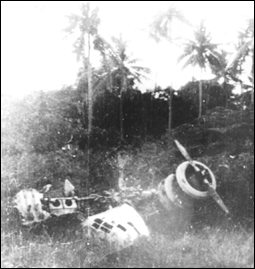 Photographs
provided by the Royal Australian Air Force Museum at Point Cook, Victoria
and technical drawings on file at Smithsonian’s Paul E. Garber Facility in
Suitland, MD have enabled us to eliminate the Tachikawa Ki-54 as a candidate
for the aircraft in the Wreck Photo. The Japanese advanced trainer produced
from 1940 until 1945 had been considered to be the primary alternative to the
Lockheed Model 10 in our efforts to determine whether the severely damaged
airplane in the photo might be Earhart’s. Other similar types which have been
considered and eliminated have been the Beechcraft Model 18, Grumman “Goose” amphibian,
and the Lockheed Model 12.
Photographs
provided by the Royal Australian Air Force Museum at Point Cook, Victoria
and technical drawings on file at Smithsonian’s Paul E. Garber Facility in
Suitland, MD have enabled us to eliminate the Tachikawa Ki-54 as a candidate
for the aircraft in the Wreck Photo. The Japanese advanced trainer produced
from 1940 until 1945 had been considered to be the primary alternative to the
Lockheed Model 10 in our efforts to determine whether the severely damaged
airplane in the photo might be Earhart’s. Other similar types which have been
considered and eliminated have been the Beechcraft Model 18, Grumman “Goose” amphibian,
and the Lockheed Model 12.
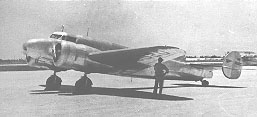 |
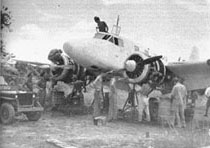 |
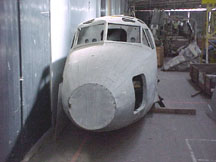
Like the aircraft in the Wreck Photo, both the Lockheed 10 (above center) and the Tachikawa Ki-54 above (right) are of stressed aluminum construction and are equipped with two-bladed, variable-pitch (but not full-feathering) propellers. Both have a single prominent windshield centerpost and a nose section featuring four transverse bulkheads covered by aluminum skins oriented fore and aft. Photographs of a Ki-54 fuselage in the collection of the RAAF Museum (left) at Point Cook show that the base of the windshield centerpost joins the fuselage at a sharp right angle.
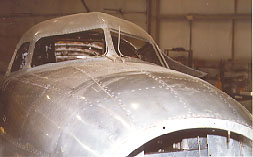 The
base of the Lockheed windshield centerpost was more stylized and
had a curved, almost Art Deco, look.
The
base of the Lockheed windshield centerpost was more stylized and
had a curved, almost Art Deco, look.
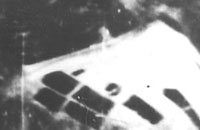 The
base of the windshield centerpost of the airplane in the Wreck Photo appears
to be more like that of the Lockheed.
The
base of the windshield centerpost of the airplane in the Wreck Photo appears
to be more like that of the Lockheed.
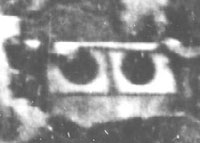
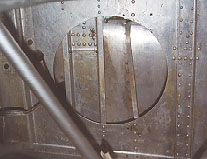 In
the Wreck Photo, the leading edge of the inboard wing section on the starboard
(right-hand) side of the airplane seems to have been cut and peeled apart
to reveal what appear to be two large lightening holes (holes cut in sheet
aluminum to make it lighter).
In
the Wreck Photo, the leading edge of the inboard wing section on the starboard
(right-hand) side of the airplane seems to have been cut and peeled apart
to reveal what appear to be two large lightening holes (holes cut in sheet
aluminum to make it lighter).
An examination of Lockheed c/n 1052 at the New England Air Museum confirmed that the structure behind the inboard leading edge of the Electra looks identical to that seen in the Wreck Photo.
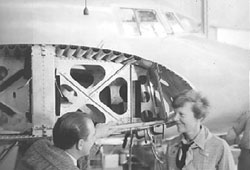
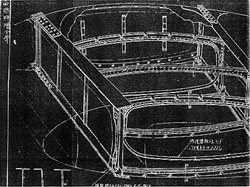
Microfilm of technical drawings of the Tachikawa Ki-54 on file at the Garber Facility show that the wing structure of the Japanese aircraft featured a solid spar behind the leading edge of the inboard wing section.
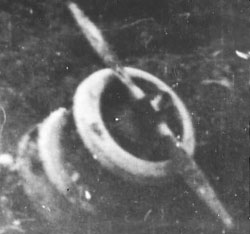 In
the absence of any other viable candidate, the most likely identity of the
airplane in the Wreck Photo would seem to be the Lockheed Model 10. All
Model 10s had nine foot Hamilton Standard propellers. Measurement of the
engine cowling using the prop as a scale shows it to be correct for the
large-engined Model 10E. Analysis of the foliage in the background of the
Wreck Photo by leading botanists at the Smithsonian’s National Museum of
Natural History confirmed that the photo could have been taken on Nikumaroro.
One detail is particularly interesting. The mature coconut palms in the
background are very unhealthy and have either suffered an infestation of
rhinoceros beetle or prolonged drought. Comparison of early maps and photos
of the island with anecdotal accounts by former residents who speak of airplane
wreckage in a specific beachfront area show that there was, indeed, a stand
of mature coconut palms in that location. Nikumaroro has always been plagued
by periodic drought. Interestingly, these same people volunteered the information
that “some white men came once in a government boat … to take pictures
of the airplane parts.” None of this proves that the Wreck Photo is
a picture of NR16020 on Nikumaroro, but so far we have not been able to
come up with anything that disqualifies that as a possibility and the alternative
explanations we've been able to think of have not held up to scrutiny. As
a matter of fact, the more we learn, the better this piece seems to fit
the puzzle.
In
the absence of any other viable candidate, the most likely identity of the
airplane in the Wreck Photo would seem to be the Lockheed Model 10. All
Model 10s had nine foot Hamilton Standard propellers. Measurement of the
engine cowling using the prop as a scale shows it to be correct for the
large-engined Model 10E. Analysis of the foliage in the background of the
Wreck Photo by leading botanists at the Smithsonian’s National Museum of
Natural History confirmed that the photo could have been taken on Nikumaroro.
One detail is particularly interesting. The mature coconut palms in the
background are very unhealthy and have either suffered an infestation of
rhinoceros beetle or prolonged drought. Comparison of early maps and photos
of the island with anecdotal accounts by former residents who speak of airplane
wreckage in a specific beachfront area show that there was, indeed, a stand
of mature coconut palms in that location. Nikumaroro has always been plagued
by periodic drought. Interestingly, these same people volunteered the information
that “some white men came once in a government boat … to take pictures
of the airplane parts.” None of this proves that the Wreck Photo is
a picture of NR16020 on Nikumaroro, but so far we have not been able to
come up with anything that disqualifies that as a possibility and the alternative
explanations we've been able to think of have not held up to scrutiny. As
a matter of fact, the more we learn, the better this piece seems to fit
the puzzle.